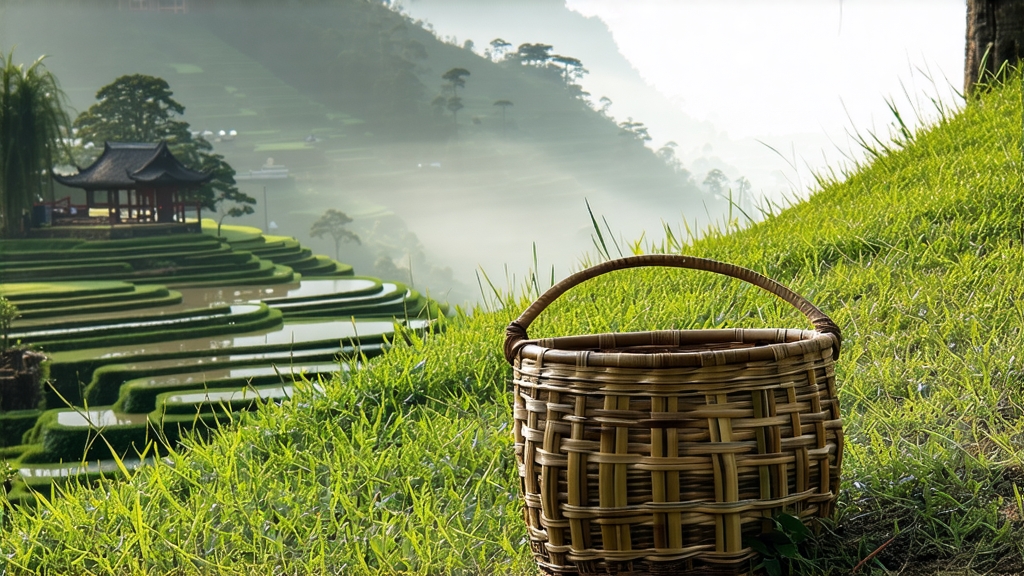
High above the bustle of Chengdu’s plain, where the Sichuan basin collides with the first ridges of the Tibetan Plateau, lies a ridge called Meng Ding—“the Summit of Meng.” At 1,450 m the air is cool, clouds drift low enough to brush the camellia bushes, and the soil is a loose, dark yellow loam laced with quartz. It was here, legend claims, that the Taoist adept Wu Lizhen planted the world’s first cultivated tea garden in 53 BCE. Two millennia later the same slopes still yield Meng Ding Huang Ya, the most revered yellow tea of southwest China, a leaf so delicately yellowed that poets once compared its liquor to “the after-glow of a late winter sun on palace silk.”
History: from hermit to emperor
Tang-dynasty chronicles (618-907) already list “Meng Mountain Bud Tea” among tribute gifts, but the colour of the leaf at that time was green. The deliberate “yellowing” process appears suddenly in court records dated 1069, when Emperor Shenzong’s tea officers demanded a softer, sweeter cup to replace the astringent early-spring greens. Monks on Meng Ding experimented with wrapping warm, half-dried leaves in yellow silk, discovering that a brief, humid rest transformed both colour and flavour. By the Ming dynasty the tea was carried 2,000 km by fast horse to Beijing, packed in small bamboo tubes sealed with rosin and stamped with the imperial dragon. After 1911 the tribute system collapsed, farmers switched to faster-paying green teas, and Huang Ya almost vanished. Rediscovery came in 1978 when a team of Sichuan agronomists found three ancient shrubs inside the old palace-garden fence, propagated them by cuttings, and re-established the cultivar on its native slope. Today only 280 mu (18 ha) are authorised to bear the name Meng Ding Huang Ya, producing barely six tonnes a year—rarer than many Burgundy grand crus.
Micro-terroir and cultivar
The garden faces east above a perennial cloud line; morning sun is diffused, UV-B is 18 % lower than on the plain, and the diurnal swing can exceed 12 °C. These conditions slow photosynthesis, stockpiling theanine while keeping catechins low. The traditional cultivar is a local large-leaf type, Camellia sinensis var. sinensis ‘Meng Ding #5’, whose spring bud weighs 0.8 g, measures 3.2 cm and carries a downy underside that looks like frost. Picking window is cruelly short: only the single bud or bud-with-just-opening-leaf plucked between 20 March and 5 April qualifies for top grade “Imperial Yellow.” One kilo of finished tea needs 42,000 such buds, all snapped before 9 a.m. while the dew is still cool.
Craft: the six steps that coax out yellow
- Withering on bamboo mats for 90 minutes—no sun, only mountain breeze—reduces moisture to 68 %.
- Kill-green at 140 °C on a cast-iron pan for 3.5 minutes; the leaf loses grassy notes but is left 40 % wet, far less than green tea.
- Rolling under light pressure for 8 minutes ruptures 18 % of cells, starting the slow release of sugars.
- First wrap: 1.2 kg of rolled leaf are wrapped in a square of steamed yellow cotton, forming a tight 25 cm bundle. The bundle rests in a cedar box at 34 °C and 78 % humidity for 48 hours. Inside, non-enzymatic browning and limited polyphenol oxidation occur; chlorophyll breaks down, carotenoids show through, and a sweet maillard aroma reminiscent of fresh corn emerges.
- Second firing at 80 °C for 20 minutes dries the leaf to 20 % moisture.
- Second wrap & yellowing, identical to the first but lasting only 24 hours, fixes the golden colour and deepens the honey note. A final gentle bake to 5 % moisture finishes the tea. The entire cycle takes five days, three times longer than spring green tea from the same mountain.
Grades & leaf style
- Imperial Needle (top): uniform buds, golden down, needle-straight, 8 mm diameter, liquor bright yellow-green.
- Special Grade: one bud and one tiny leaf, still needle-shaped but 1.5 cm long, liquor deeper yellow